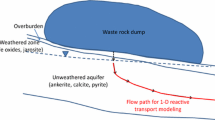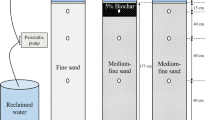Abstract
In this study, laboratory experiments were combined with numerical modeling to study the water quality variation and hydrogeochemical evolution of recharged water during the aquifer groundwater recharge (AGR). Reclaimed water from wastewater treatment plant (WWTP) was recharged into a one-dimensional column filled with field sediments. The chemical reactions, soil-soluble species dispersion, mineral dissolution and precipitation, adsorption, and cation exchange in the recharge aquifer zone were examined. The study showed that the pH of the system varied from 6.31 to 7.77 during the 159-h experiment process. Mineral dissolution and cation exchange were dominant for Al, Zn, and Fe, and absorption caused As and Se to always tend toward 0 during leaching. Dissolution caused total nitrogen and dissolved organic carbon to form additional contaminants in the preliminary stage. The 3-D excitation/emission matrix spectra illustrated the humus in sediments were a potential threat to the groundwater quality by leaching. By fitting the major ions like Na+, Ca2+, Cl−, and HCO3− using PHREEQC soft, we developed a solute transport model and used them to predict the hydrogeochemical evolution under different migration lengths. Through the analysis for pH, ionic strength, and hardness index, we think that at the initial time, the effluent after transporting 25 m accorded with the standard of class I water quality index of groundwater. The study can be used to provide theoretical foundation and lead the field practice.
















Similar content being viewed by others
References
Ak M, Gunduz O (2013) Comparison of organic matter removal from synthetic and real wastewater in a laboratory-scale soil aquifer treatment system. Water Air Soil Pollut 224:1467
Amini A, Hesami A (2017) The role of land use change on the sustainability of groundwater resources in the eastern plains of Kurdistan, Iran. Environ Monit Assess 189(297):297. https://doi.org/10.1007/s10661-017-6014-3
Amini A, Ali TM, Ghazali AHB, Aziz AA, Akib SM (2011) Impacts of land-use change on streamflows in the Damansara Watershed, Malaysia. Arab J Sci Eng 36:713. https://doi.org/10.1007/s13369-011-0075 -3, 720
Antoniou EA, Stuyfzand PJ, van Breukelen BM (2013) Reactive transport modeling of an artificial groundwater recharge (AGR) pilot to assess long-term water quality improvements and potential solutions. Appl Geochem 35:173–186
Chen Y, Lerner O, Tarchitzky J (2003) Hydraulic conductivity and soil hydrophobicity: effect of irrigation with reclaimed wastewater, in: Lundstrom, U. (Ed.), 9th Nordic IHSS symposium on abundance and functions of natural organic matter species in soil and water. Mid-Sweden University, Sundsvall, Sweden, p 19
Chol DT, Abel CDT, Sharma SK, Malolo YN, Maeng SK, Kennedy MD, Amy GL (2012) Attenuation of bulk organic matter, nutrients (N and P), and pathogen indicators during soil passage: effect of temperature and redox conditions in simulated soil aquifer treatment (SAT). Water Air Soil Pollut 223:5205–5220
Cui XC, Zhou DD, Fan W, Huo XM, Crittenden CJ, Yu ZS, Ju PF, Wang Y (2016) The effectiveness of coagulation for water reclamation from a wastewater treatment plant that has a long hydraulic and sludge retention times: a case study. Chemosphere 157:224–231
Essandoh HMK, Tizaoui C, Mohamed MHA, Amy G, Brdjanovic D (2011) Soil aquifer treatment of artificial wastewater under saturated conditions. Water Res 45:4211–4226
Goren O, Gavrieli I, Burg A, Lazar B (2011) Cation exchange and CaCO3 dissolution during artificial recharge of effluent to a calcareous sandstone aquifer. J Hydrol 400:165–175
Hu JD, Shen YT, Wang XJ (2009) The effect of ionic strength and pH conditions on the release, deposition and dispersibility behaviors of natural soil colloid. Ecol Environ 18(2):629–637
Jarusutthirak C, Amy G (2007) Understanding soluble microbial products (SMP) as a component of effluent organic matter (EfOM). Water Res 41(12):2787–2793
Masumeh T, Mohamad HMG, Jalil M, Reza A, Saugata D (2017) Hydrogeochemical and isotopic evaluation of arsenic contaminated waters in an argillic alteration zone. J Geochem Explor 175:1–10
McBride MB (1995) Toxic metal accumulation from agricultural use of sludge: are USEPA regulations protective. J Environ Qual 24:5–18
Nadav I, Arye G, Tarchitzky J, Chen Y (2012) Enhanced infiltration regime for treated-wastewater purification in soil aquifer treatment (SAT). J Hydrol 420-421:275–283
Nema P, Chelani A, Ojha CSP, Kumar A, Khanna P (2004) Utility of column lysimeter for design of soil aquifer treatment system for wastewater renovation using artificial neural networks. J Environ Eng 130:1534–1542
Orly O, Ittai G, Avihu B, Joseph G, Boaz L (2007) Manganese mobilization and enrichment during soil aquifer treatment (SAT) of effluents, the Dan Region Sewage Reclamation Project (Shafdan). Israel Environ Sci Technol 41:766–772
Page D, Vanderzalm J, Barry K, Levett K, Kremer S, Ayuso-Gabella MN, Dillon P, Toze S, Sidhu J, Shackleton M, Purdie M (2009) Operational residual risk assessment for the Salisbury stormwater ASTR project. CSIRO: water for a healthy country National Research Flagship Report
Page D, Miotlinski K, Dillon P, Taylor R, Wakelin S, Levetta K, Barry K, Pavelic P (2011) Water quality requirements for sustaining aquifer storage and recovery operations in a low permeability fractured rock aquifer. J Environ Manag 92:2410–2418
Parkhurst DL, Appelo CAJ (1999) User's guide to PHREEQC (version 2): a computer program for speciation, batch-reaction, one-dimensional transport, and inverse geochemical calculations. US Geological Survey, Water-Resources Investigations Report 99–4259, Denver
Pavelic P, Nicholson BC, Dillon PJ, Barry KE (2005) Fate of disinfection by-products in groundwater during artificial groundwater recharge with reclaimed water. J Contam Hydrol 77:119–141
Pavelic P, Dillon JP, Barry EK, Vanderzalm LJ, Correll LR, Rinck-Pfeiffer MS (2007) Water quality effects on clogging rates during reclaimed water ASR in a carbonate aquifer. J Hydrol 334:1–16
Saha UK, Taniguchi S, Sakurai K (2002) Simultaneous adsorption of cadmium, zinc, and lead on hydroxyaluminum-and hydroxyaluminosilicate-montmorillonite complexes. Soil Sci Soc Am J 66:117–128
Smedley PL, Kinniburgh DG (2002) A review of the source, behaviour and distribution of arsenic in natural waters. Appl Geochem 17:517–568
Wang ZJ, Du XQ, Yang YS, Ye XY (2012) Surface clogging process modeling of suspended solids during urban stormwater aquifer recharge. J Environ Sci 24(8):1418–1424
Zhang ZM (2015) Analysis of reclaimed water quality dynamic and the effect of clogging of drip irrigation in Hohhot. Inner Mongolia Normal University, Inner Mongo in Chinese
Zhang JS, Tao S, Cao J (2011) Spatial distribution pattern of water soluble organic carbon in eastern China. ACTA PEDOLOG ICA SINICA 38(8): 308–314 (in Chinese)
Funding
This work was supported by the National Natural Science Foundation of China (NSFC No. 51238001 and 51678121) and technological development plan project of Jilin Province (No. 20160520022JH).
Author information
Authors and Affiliations
Corresponding author
Rights and permissions
About this article
Cite this article
Zhang, H., Huo, M., Fan, W. et al. Water quality variation and hydrogeochemical evolution during artificial groundwater recharge with reclaimed water: laboratory experimental and numerical simulation study. Arab J Geosci 11, 340 (2018). https://doi.org/10.1007/s12517-018-3704-2
Received:
Accepted:
Published:
DOI: https://doi.org/10.1007/s12517-018-3704-2




